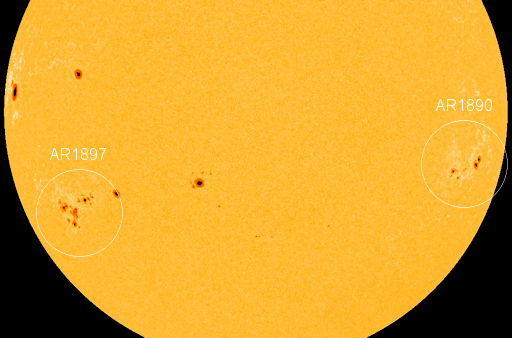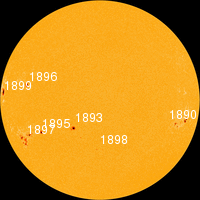~ Space Weather Update~ WAITING FOR THE NEXT FLARE [1]
WHAT WENT WRONG ON MARS? Mars was once on track to become a thriving Earth-like planet, yet today it is an apparently lifeless wasteland. A NASA spacecraft named MAVEN will soon journey to Mars to find out what went wrong on the Red Planet. Get the full story [2] and a video [3] from Science@NASA.
WAITING FOR THE NEXT FLARE: Solar activity has been low for 24+ hours, but the forecast calls for flares. Two large, complex sunspots are transiting the Earthside of the sun with mixed-polarity magnetic fields that harbor energy for strong eruptions. The next big flare will probably come from one of these two circled regions:
NOAA forecasters estimate a 60% chance of M-class [5] flares and a 30% chance of X-flares [5] during the next 24 hours. Flares from AR1890 could be particularly geoeffective. Because of the way the sun's magnetic field spirals [6] through interplanetary space, AR1890 is magnetically connected to our planet. Particles accelerated by an explosion there would be guided in our direction, possibly causing a radiation storm around Earth. Stay tuned. Solar flare alerts: text [7], voice [8]

Solar wind
speed: 375.5 km/sec
density: 1.4 protons/cm3
explanation [9] | more data [10]
Updated: Today at 1616 UT
X-ray Solar Flares
6-hr max: M1 1520 UT Nov13
24-hr: M1 1520 UT Nov13
explanation [11] | more data [12]
Updated: Today at: 1600 UT
![]()
Daily Sun: 13 Nov 13
Sunspot AR1890 has a 'beta-gamma-delta' magnetic field that harbors energy for X-class [5] solar flares. Sunspot AR1897 has a 'beta-gamma' magnetic field capable of producing M-class [5] flares. Credit: SDO/HMI
![]()
Sunspot number: 147
What is the sunspot number? [14]
Updated 13 Nov 2013
Spotless Days
Current Stretch: 0 days
2013 total: 0 days (0%)
2012 total: 0 days (0%)
2011 total: 2 days (<1%)
2010 total: 51 days (14%)
2009 total: 260 days (71%)
Since 2004: 821 days
Typical Solar Min: 486 days
Update 13 Nov 2013
The Radio Sun
10.7 cm flux: 168 sfu
explanation [15] | more data [16]
Updated 13 Nov 2013
![]()
Current Auroral Oval:
Switch to: Europe, USA, New Zealand, Antarctica
Credit: NOAA/POES
![]()
Planetary K-index
Now: Kp= 2 quiet
24-hr max: Kp= 2 quiet
explanation [18] | more data [19]
Interplanetary Mag. Field
Btotal: 3.4 nT
Bz: 1.9 nT south
explanation [20] | more data [21]
Updated: Today at 1616 UT
![]()
Coronal Holes: 13 Nov 13
Solar wind flowing from the indicated coronal hole could reach Earth on Nov. 16-17. Credit: SDO/AIA.



